The people of Kelantan are known for their hospitality. The largely rural state preserves rich Malay traditions such as kite-flying contests, top-spinning contests, and bird singing competitions, and traditional handicrafts such as batik, songket, and silver crafts. As a border state and former vassal state of Thailand, Kelantan has absorbed influences from Thai customs and traditions that help to make the state's culture distinct from those of other states of Malaysia. The Kelantanese people, regardless of ethnic origin, are very proud of their state and its unique local culture and dialect.
All the ethnicities generally live together harmoniously in Kelantan. For example, members of the Thai community received a permit to build a very large statue of the Buddha without any objection from the Malay community or the PAS government that granted the permit.
Kelantan Malays consider themselves an unusual breed. Many have some Thai ancestry, as intermarriages between the Thais and Malays have been and remain common. Kelantan Malays also note differences between themselves and the Malays of other states. The Patani Malays of southern Thailand are closely related to the Malays of Kelantan.
Kelantanese Malay dialect is distinguished from standard Malay as well as other Malay dialects by its unique grammar, pronunciation and figures of speech.
Kelantanese Malay is the only lingua franca of the state, is used in the local mass media, and is so commonly used for daily communication that some Kelantanese cannot speak the standard form of Malay, as promoted by the Federal Government. The dialect is also prevalent beyond the state borders into southern Thailand and in Besut, the northernmost district of Terengganu. Whilst the Arab script called Jawi has less influence in the other parts of Malaysia, it is still widely used in writing and printing the Malay language in Kelantan. Signboards in Kelantan are written in both Jawi and Rumi. To a certain extent, Thai is also used.
95% of Kelantan's population are ethnic Malay, and under the Malaysian Constitution, all Malays are Muslims; therefore, Islam is the most influential religion in the state.
To most Malaysians, Kelantan is synonymous with Malay arts and crafts. Kota Bharu, as the state capital, is a popular centre for such pursuits as silat, martial arts, and kertok drumming. Here, too, more than any other place in Malaysia, the traditional pastimes of top-spinning — known as gasing — and the flying of giant, elaborately-decorated kites called wau, are still much in evidence.
The ethnic Thai inhabitants of Kelantan are mostly centered in an area around the coastal town of Tumpat, site of most of the state's two hundred or so Buddhist temples, and noteworthy for its number of relatively well-off Siamese villages.
The dialect of the Thai language spoken in Kelantan is called "Tak Bai", after the southernmost coastal town Tak Bai of Narathiwat Province, just across the Golok River from Malaysia. Tak Bai dialect differs substantially from standard southern Thai and other regional Thai dialects, and it seems certain that the Kelantan Thais are the descendants of an original enclave of Narathiwat settlers established in sparsely-populated Malay territory as long as four centuries ago.
Buddhism is also visible, in that hundreds of Thai wats can be found throughout the state. The longest statue of a sleeping Buddha in Southeast Asia can be found in Wat Photivihan, in Tumpat.
List of Wat: Wat Photivihan Wat Phithikyan Phutthaktham Wat aril Wat Phathumviharn... etc
The reclining Buddha at Wat Photivihan in KelantanOpened in 1980, this temple is very popular with pilgrims and devotees. The Buddha statue is believed to be about forty meters long. There are visitors who are surprised to see a temple of such size in this Muslim majority state but the reason is due to the fact that this district is filled with strong Thai influenced. Usualy the Metta Chanting is using the original langguage (Bali), or in Thai transilation.
The Thai group will conduct the religious celebration at the Wat such as Tok'katinna, Loy krathong, saibat, sonkrang, and so forth. sometime a thousand of visitor will go to join the function.
[edit] Chinese
Chinese assimilation in Kelantan is manifested as: "Malay behaviour as frontstage and Chinese behaviour as backstage". "Frontstage" or public behaviour includes speaking Kelantanese Malay even when among themselves, adopting Malay-style clothing, and observing certain Malay customs and holidays. "Backstage" or private behaviour includes maintaining certain traditional Chinese beliefs and customs confined only within the home. Many Kelantanese Chinese feel a sense of separateness from other Malaysian Chinese people due to their illiteracy and lack of fluency in Chinese.
In Kelantan, the Chinese see themselves as either Cina Kampung (village Chinese) or Cina Bandar (town Chinese). Famous Chinese villages in Kelantan include Kampung Tok'kong (300 year old temple), Batu Jong, Kampung Jelatok, Kampung Temangan, Kampung Mata Ayer, Kampung Tawang, Kampung Balai, etc.
In other parts of Malaysia, the Chinese see themselves as Hokkien, Cantonese, Hakka, identifying themselves by the Han subgroup their ancestors were part of in China. However, this is not so in Kelantan. Descendants of the earlier waves of small-scale migration are known as Orang Cina kita (our very own Chinese) and the elders are seen as Orang Kelantan betul (true Kelantanese). Speaking the Kelantanese Malay dialect with fluency unites both Cina Kampung and Cina Bandar.
The Chinese in Kelantan have native speaker competence in the Kelantanese dialect. It is impossible to tell a Malay from a Chinese by just listening to his speech in the Kelantanese dialect, without looking at the person.
The accommodations of the Chinese population have made communication between Chinese and Malays in Kelantan both easy and common. As a consequence, Kelantanese and Chinese view each other as individuals, rather than simply as representatives of cultural categories. The ability of the Chinese in Kelantan to accommodate Malay culture has facilitated significant entrepreneurial activities.
Much of Chinese culture still continues until today; such as lion dancing during the CNY, temple celebration, religious celebration.
The village of Kampung Tok'kong in the Kelantan state of Malaysian is known for a historically significant Chinese Temple known as Seng Choon Keong. With the 500 of villagers. The temple is dedicated to the worship of the Goddess Matsu. The temple is approximately 300 years old. Every year on the equivalent date to the 23rd of March on the Chinese Calendar, the birthday of Mazu is commemorated. Chinese, especially Mazu followers go there to pay homage to Mazu, and to offer prayers for health and wealth, as well as for personal safety and security. Annually, the Seng Choon Keong lion dance association will tour the state during the Chinese New Year to conduct traditional cultural rituals aimed at driving away evil spirits and bad luck.
For the funeral, mostly the chinese villager will burried the boddies at their hometown cementary land, but part of them will take it to nearest Wat to burn it. usualy they will conduct three day funeral function for the older, but for the youngster will burried or burn it as soon as posible.
[edit] Orang Asli
In addition, there are Orang Asli, mostly Temiar, a people who have lived in the forests of Kelantan and Perak for thousands of years. Some of the Temiar maintain traditional beliefs in their natural surroundings and other forms of animist elements, while some of them have embraced Islam, instead.
[edit] Cuisine
The Kelantanese cuisine, heavily influenced by Thai cuisine, is quite popular among Malaysians. In fact, many visitors come to Kelantan just to taste the special delicacies that cannot be found elsewhere. The use of sugar is a must in every Kelantanese kitchen, and thus most Kelantanese dishes are sweet.
Kelantanese food makes more use of coconut milk than anywhere else in the country. Curries are richer, creamier, and more influenced by the tastes of nearby Thailand.
[edit] Local specialties
Apart from delicacies imported from Thailand, there are delicacies which are invented by the Kelantanese themselves such as:
This is a mix of white rice and brown glutinous rice (special glutinous rice) which is cooked with coconut milk (santan), blended onions and garlic and some spices (such as fenugreek) (Malay: halba). Fish or chicken curry comes as an add-on to complete the dishes together with mildly brown sugared sambal (chili paste), so it's recommended to take only a small portion as it is extremely filling. The Nasi Dagang is one of the tastiest dishes in Kelantan and goes well with fish curry, pickle, hard-boiled eggs. See here for the main article about Nasi Dagang
Nasi Kerabu literally means "salad rice". Kelantan has a variety of Nasi Kerabu. Nasi kerabu biasa (normal) or nasi kerabu putih (white) which comes with its own sambal tumis (a special coconut milk based gravy with local herbs and spices, with a hint of chillies) or Nasi kerabu Hitam (black) though the actual color is blue (after the rice is soaked and cooked with a local flower although some people use artificial equivalents) and nasi kerabu kuning (yellow) which use tumeric in the preparation of the rice. Nasi Kerabu Hitan and Kuning does not require a sambal tumis, instead, it has a watery chilly sauce which makes it slightly hotter. The “kerabu” (salad) could be any vegetables or edible leaves though the more or less standard version will have daun kesum, taugeh (bean sprout), thinly cut; long green beans, bunga kantan, cucumber (connoisseurs will insist “seeded”), and daun kadok. Apart from that it is also served with fried breaded fish, keropok keping, salted egg, "solok lada" (fish fillet and coconut-stuffed chillis), and pickled garlic (local gherkins)
Rice packed in a cone-shaped banana leaf. A pack of Nasi Tumpang consists of an omelette, meat floss, chicken and/or shrimp curry and sweet gravy. It is traditionally meant for travellers.
Wood-fire broiled chicken dressed with sweet coconut gravy. Ayam Golek/Ayam Percik is eaten with white rice in major family dishes and serve during a feast.
Most Kelantanese have Nasi Berlauk as their breakfast. Nasi Berlauk is rice served with fish or chicken and vegetables cooked with tumeric and galangal infused yellow gravy.
Ulam is the local term for raw vegetables - the meal consists of white rice served with a variety of raw vegetables, and is considered one of the healthiest dishes found in Malay cuisine.
Also termed as chlorophyll rice, the Kau-Jam is a green rice cooked using up to seven types of herbs, and served with raw vegetables (such as bean sprouts, cucumber, and long beans), fish flakes and local Keropok. The meal is often accompanied by Budu and sometimes served with deep-fried fish.
These are Kelantanese fish crackers. Their texture and colour are noticeably rougher and darker than the usual variety found on the West Coast of Malaysia. Like the curries, the crackers are influenced by Thai cooking and produce a sharper, saltier taste.
These are Kelantanese fish sausages. Made by combining fish flesh and sago, keropok gote is rolled into long firm sticks and then steamed or boiled. To enjoy it, one has to cut it into desired bite sized and deep fried. Different from Terengganu's keropok lekor, the Kelantan variety is thicker and longer in size and has to be fried to be eaten. Keropok Gote is probably the one snack which all Kelantanese children grow up with. It is a must at all school canteens.
The Laksa dish, white noodles served with gravy (curry or otherwise) and vegetables, is made differently in every state in Malaysia. The laksa Kelantan employs the creamy white gravy which is richer and has full-bodied flavour. The main ingredient is fish flesh, although connoisseurs would certainly prefer the ones made of eels. Laksam is another version with thicker noodle (similar to kuey teow). Laksa or laksam is served with ulam similar in nasi kerabu, with a pinch of salt and belachan for added taste
In English, 'Chocolate Banana' which is supposedly the favourite flavour of ice cream in the Kelantan district.
[edit] Thai-influenced dishes
Perhaps the most characteristic Kelantanese-Thai dish is 'kaeng matsaman'—a mouth-watering beef curry cooked with peanuts, potatoes and chopped red onions in a thick coconut milk sauce. Other Kelantanese-Thai specialties include: 'kaeng phanaeng kai'—savoury chicken and coconut curry. 'Kaeng som nom mai dong'—hot and sour fish ragout with pickled bamboo. 'Pla see siad haeng thawt'—deep fried semi-dried pla see fish. 'Khao yam pak tai'—an intriguing breakfast salad. The presentation is exquisite. A small pile of fragrant boiled rice, accompanied by finely chopped heaps of lemon grass, peanuts, bean sprouts, green beans, sour mango and chopped makrut or kaffir lime is served with spicy chilli pepper, fresh lime and a piquant sweet-sour sauce. It's unusual, elegant, and very typical of Kelantan. Kelantanese dishes, like central Thai, are usually accompanied by generous helpings of 'khao suay', or "beautiful rice"—the best of which, 'khao hawm mali', or jasmine-fragrance rice, is steamed until each grain is tender but separate. When something tastes this good, the Thais utter in full emotion:-"Pisek!"
- Somtam
- Somtam is a papaya salad with a salty, spicy, and sour taste. The main items in it are young, unripe papaya, soy sauce, groundnuts, fish sauce, lime juice, and chilies. These items are combined in a mortar, pounded with a pestle for few seconds and served. The salty and lime juicy taste is very popular. This light dish is widely available in regions with large numbers of ethnic Thais, such as Tumpat and Siamese wats.
- Cholek
- Contrary to popular belief, Cholek is not just a dipping sauce, but can also refer to a snack eaten with the sauce. Cholek comes in various forms, including meaty cholek, cholek ayam (chicken), cholek perut (cow intestines), cholek pelepong (paru-liver), and also a variety of cholek buah (fruits)m such as cholek pauh (mango).
The sauce or "the cholek" comes in various forms. • Cholek manis (with brown sugar). • A sweet, sour and very mildly hot version. This cholek is different from other chili sauces because cholek is very thin and rather sweet. This dipping sauce is used for any kind of chicken, but also goes well with shrimp, fish cake, spring roll, sausage, etc.
- Budu
- Budu is a salted (fermented) anchovy sauce eaten with rice, grilled fish and vegetables/salads (ulam). A bit of lime juice, hot chilis and onions are added on for taste. Also, tempoyak (fermented durian) or fresh durian is added for good measure.
Once so combined, the purple-brownish condiment has a blend of salty and sour taste. Nowadays, other types of fish are also used to create Budu. Famous budu maker villages are Kg. Tawang, Bachok and Kg. Penambang near Kota Bharu. Similar sauces are found in the Philippines and Indochina (Vietnam, Cambodia).
- Tempoyak
- Tempoyak is a fermented durian dip, used with normal white rice. Most unforgettable is eating the 'tempoyak+budu+ulam'.
Those with high blood pressure should beware of the high salt content of this condiment, however.
- Pakpek
- Another famous Thai dish is 'pakpek belut'. The main ingredient of this cook is eel. Many Thai restaurants around Tumpat and Wakaf Bharu make this dish their main attraction. Some customers prefer it spicy, and some prefer it less spicy. This dish is not easy to cook; it needs some experience in handling the heat, natural ingredients, salt, and the eel itself. This dish is also influenced by Chinese cuisine, for whom there is a belief that eating this exotic food is more healthy.
If u plan to visit kelantan, dont miss the thai base dishes at famous restaurant at Wakaf Bharu, and tumpat. The chiangmai restaurant, pattani restaurant, A'han thai restaurant, etc. They surely will not dissapoint the tourist.
[edit] Culture
Kelantan is known as the cradle of Malay culture based on the diverse cultural activities practised by Kelantanese. [1] Among the popular cultural practices are Dikir barat, Wayang Kulit, Mak Yong, kite-flying, top-spinning, silat, bird-singing competition and handicrafts.
Among the handicraft products that are songket, batik, silverware and mengkuang. The Kandis Recource Centre provides information on the Kelantanese wood carving.
[edit] Government structure of Kelantan
[edit] Districts
Districts in Kelantan are called Jajahans, though actually the direct translation of Tanah Jajahan in Malay to English is 'Occupied Territories'. Kelantan was a divided feudal state, a common situation in the Malay Peninsula, with separate petty local rulers. However, a strong one managed to rise and conquer all these small petty territories. In the end, Kelantan became united under one Sultan.
The jajahans, from left to right, are written in Rumi and Jawi:
- Jajahan Kota Bharu (كوتا بارو)
- Jajahan Pasir Mas (ڤاسير مس)
- Jajahan Tumpat (تومڤ)
- Jajahan Pasir Puteh (ڤاسير ڤوتيه)
- Jajahan Bachok (باچوق)
- Jajahan Kuala Krai (كوالا كراي)
- Jajahan Machang (ماچڠ)
- Jajahan Tanah Merah (تانه ميره)
- Jajahan Jeli (جيلي)
- Jajahan Gua Musang (ڬوا موسڠ)
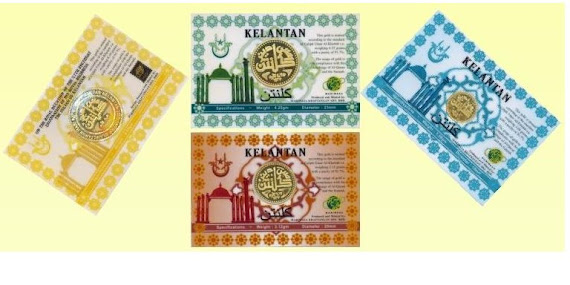
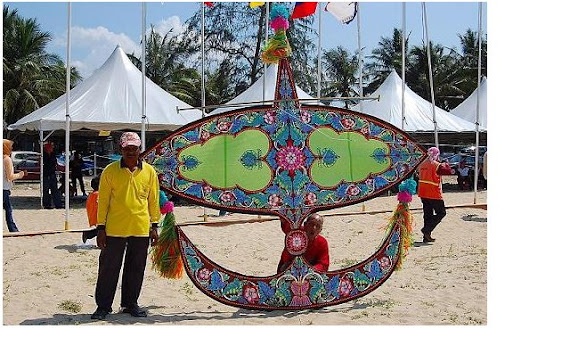
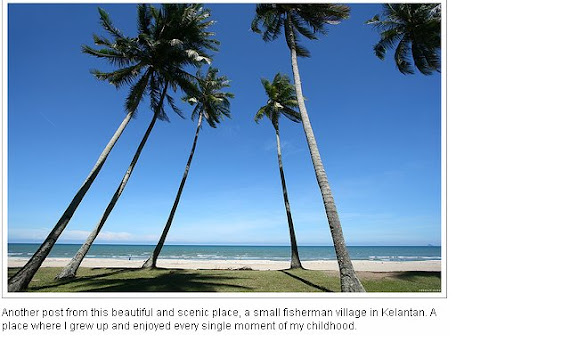
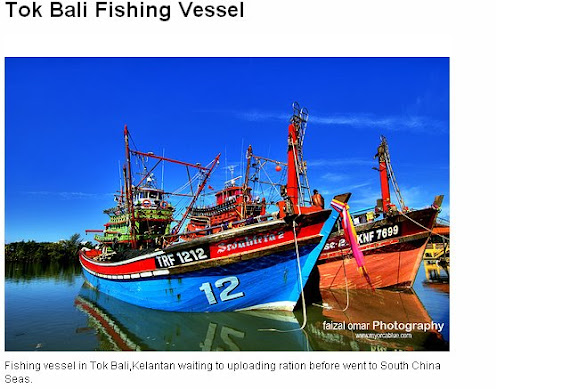
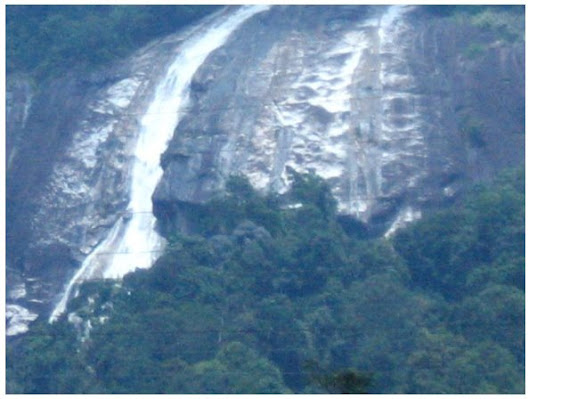
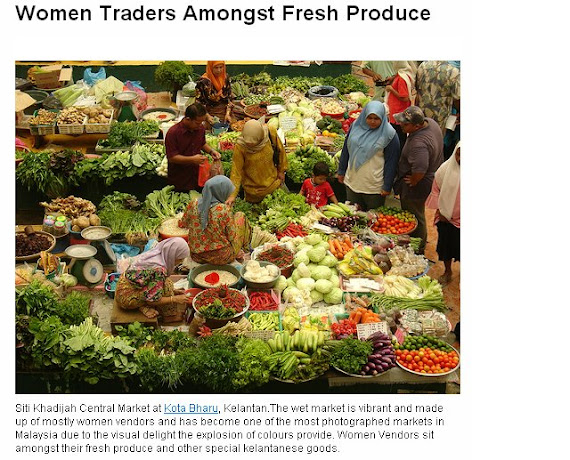
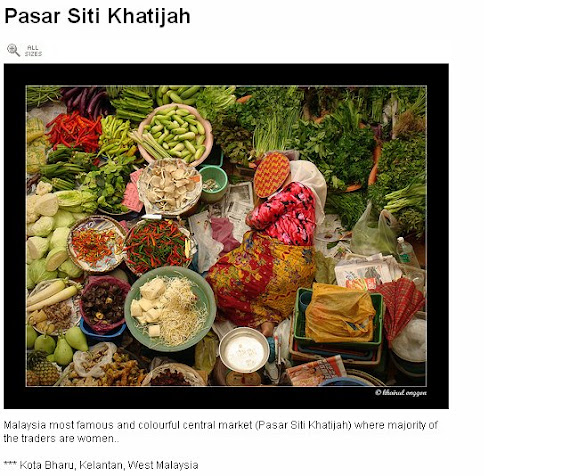
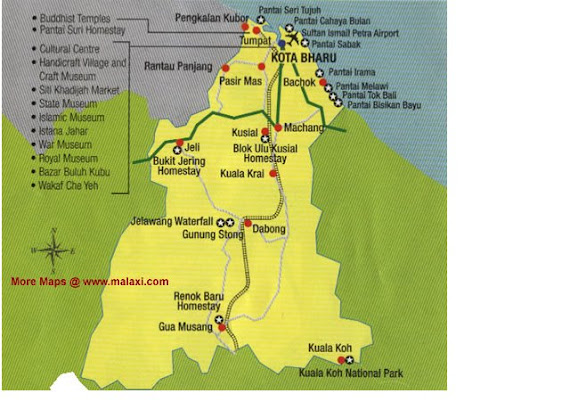
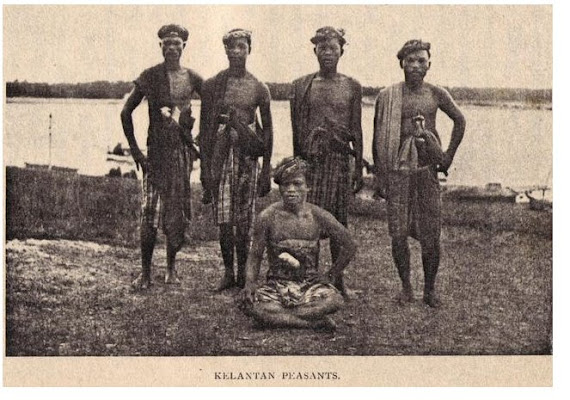
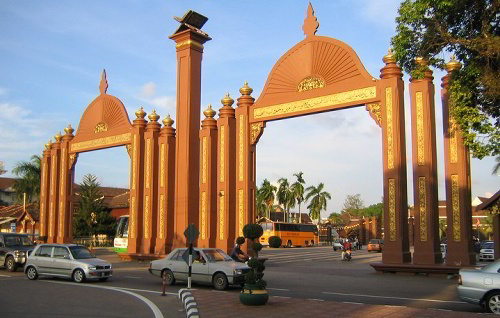
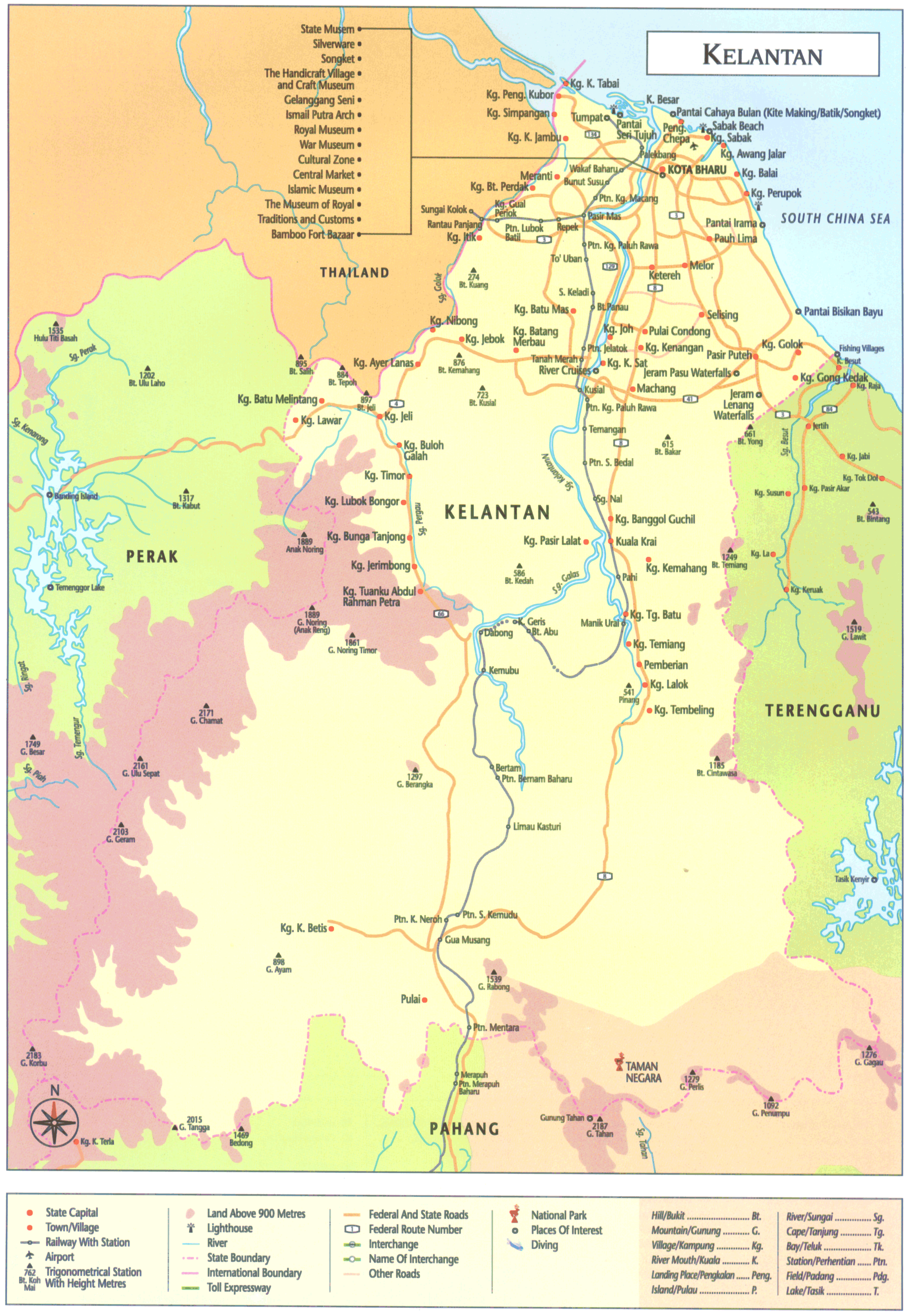


2 comments:
SALAM,
Kawe nak copy sikit posting tentang Kelantan...
Want to explore the beauty of south India? AGISE Tours and Travels offer you affordable tour packages To south India that to enjoy the exhilarating beauty of South India.
Post a Comment